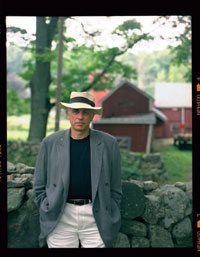The kind of Christianity that pervades the religious right in this country divides the world between the saved and the damned, between God's people and Satan's people, between good and evil. We have all seen how this is played out in our politics. I used to think that President Bush was using this language as a political ploy. I still think he is, but I also think—to my disappointment—that he also believes it. His conviction that he is God's chosen one to "rid the world of evildoers" blinds him to the evil that he—and we, as Americans—are capable of doing. The conviction that we are on the side of good—of God—is, however, an ancient one—enormously powerful.
Christians invoking terms such as "evil-doers" read the bible, as anyone does, selectively. They choose the parts they like and they leave out the parts they don't. In this case the parts they like are the parts about an eye for an eye and a tooth for a tooth, that is—and a life for a life. If someone's taken a life, then their life is required. And that's certainly a biblical tenet. Of course, it's from the Old Testament. You don't hear much about forgiveness and turning the other cheek from our President and his administration. The Old Testament is what they choose for this occasion because it suits their purpose.
What I've learned through studying the Gospel of Thomas and the context of the politics of early Christianity, is that anyone who participates in Christian tradition without having learned anything about it—and that's most people who participate in it, because it's not taught in public or private schools for the most part—often think of their traditions as immutable, as if they've just come down from God.


Introduction
by John Brockman
"Does President George W. Bush speak for God?," asks the eminent religious historian Elaine Pagels. "Are the acts of war he demands 'what Jesus would do'? Do we believe that those who disagree with his policy and question his tactics stand on the side of evil?"
Pagels, author of the seminal book The Gnostic Gospels (1979) and the recently published Beyond Belief, is well-suited to appraise these issues. To begin, she looks at the discovery made in Upper Egypt of ancient Christian texts from the beginning of the Christian era. These discoveries, according to Pagels, are transforming the way we look at Western culture and the history of religion in the West. Her work centers on the diversities of the beginning of Western religion and how our perception of that is being transformed through these discoveries.
"What was discovered in December, 1945, was a large library of ancient manuscripts which ranged from classical texts to early Christian texts, which transformed the way we see the beginning of the Christian movement. Many people have seen it as monolithic, as if it were a tradition that just keeps accreting and building and basically saying the same thing. We now see that Christianity, like Judaism, like Islam, is enormously diverse in its beginning and could have turned out very differently from what we see now. Some of the most fascinating discoveries in this find include the Gospel of Thomas, a collection of early sayings attributed to Jesus—it starts out with the words 'These are the secret words which the living Jesus spoke and which the twin Thomas wrote down.'"
"What I've learned through studying the Gospel of Thomas and the context of the politics of early Christianity," she says, "is that anyone who participates in Christian tradition without having learned anything about it, and that's most people who participate in it, because it's not taught in public or private schools for the most part—often think of their traditions as immutable, as if they've just come down from God."
The end result, she notes, is that "one can see how appeals to religion, like those that are currently being made by the religious right, can work in a democracy to subvert all of the values to which they give lip service. It worked brilliantly with the Roman Empire. Beliefs are overrated in Christianity. Religious traditions have to do with a lot more than beliefs."
As far as Bush's war to save the world from evil, she points out that as "president, not Messiah, he has a humbler, more human-sized task—and a great one: to uphold the Constitution and to serve and protect our people. The founding fathers of this nation, most of them Christians who were painfully aware of the horrors enflamed by religious wars, wrote into our Constitution a clear separation of the federal government from religion—including their own."
"While the Constitution does protect religious freedom of worship, it's supposed to protect secularism."
— JB

As a young researcher at Barnard College, ELAINE PAGELS changed forever the historical landscape of the Christian religion by exploding the myth of the early Christian Church as a unified movement. Her findings were published in 1979 in the best selling book, The Gnostic Gospels, which won the National Book Critics Circle Award and the National Book Award. The is was followed later that year with her selection as one of the first three recipients of the MacArthur Award.
Pagels' latest book, Beyond Belief, was published in May. Her other books include The Origin of Satan and Adam and Eve and the Serpent. She is the Harrington Spear Paine Professor of Religion at Princeton University and has published widely on Gnosticism and early Christianity.
Elaine Pagel's Edge Bio Page























